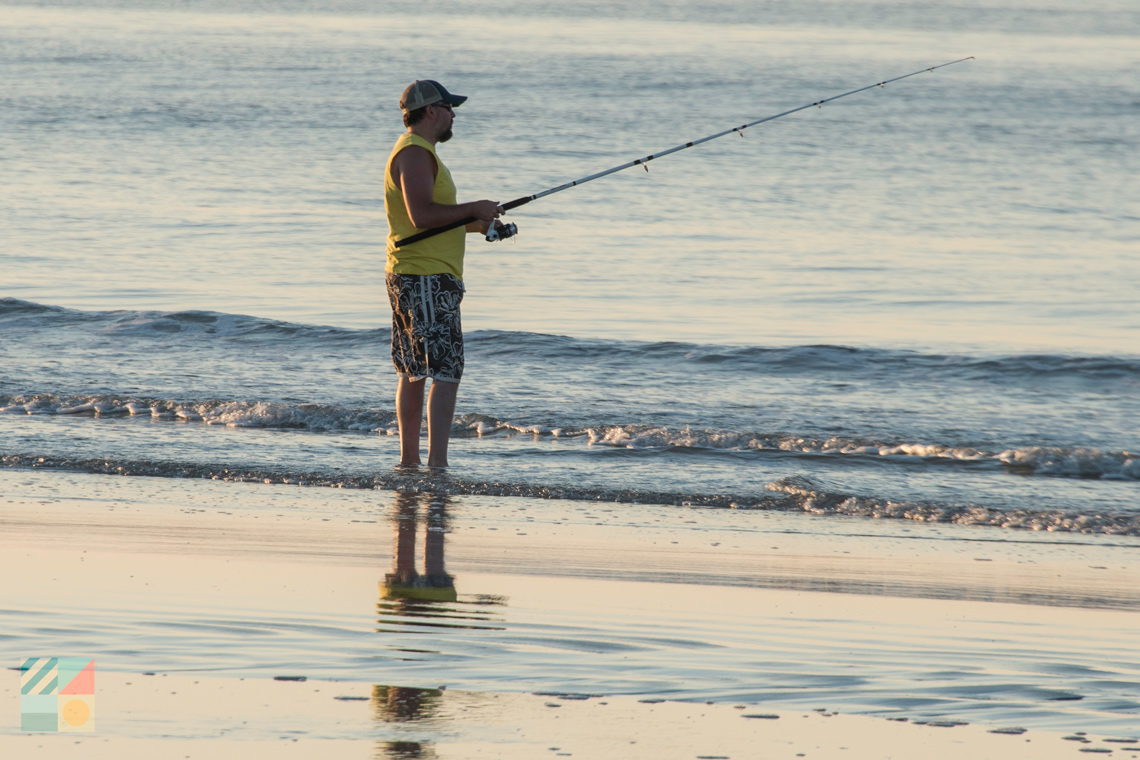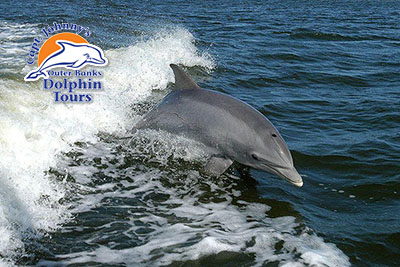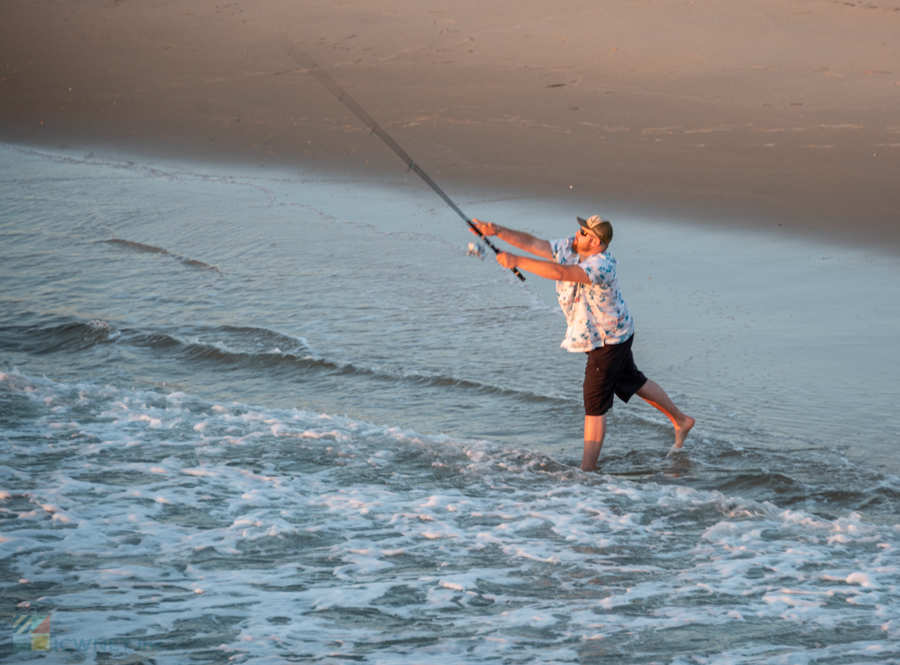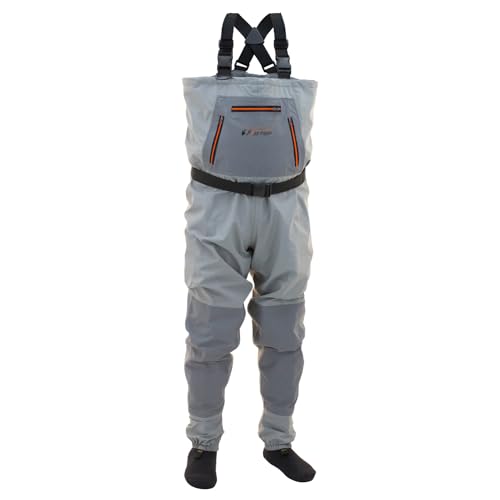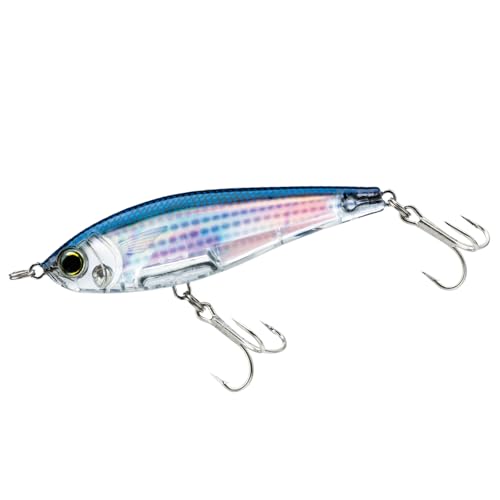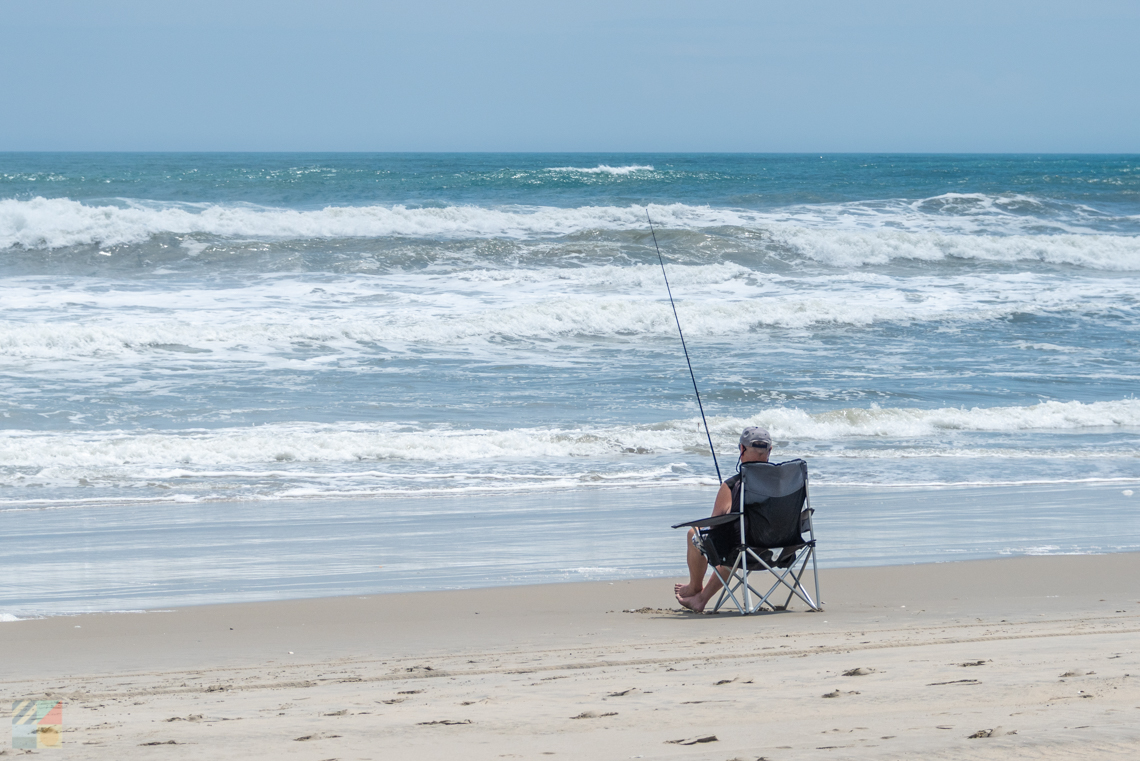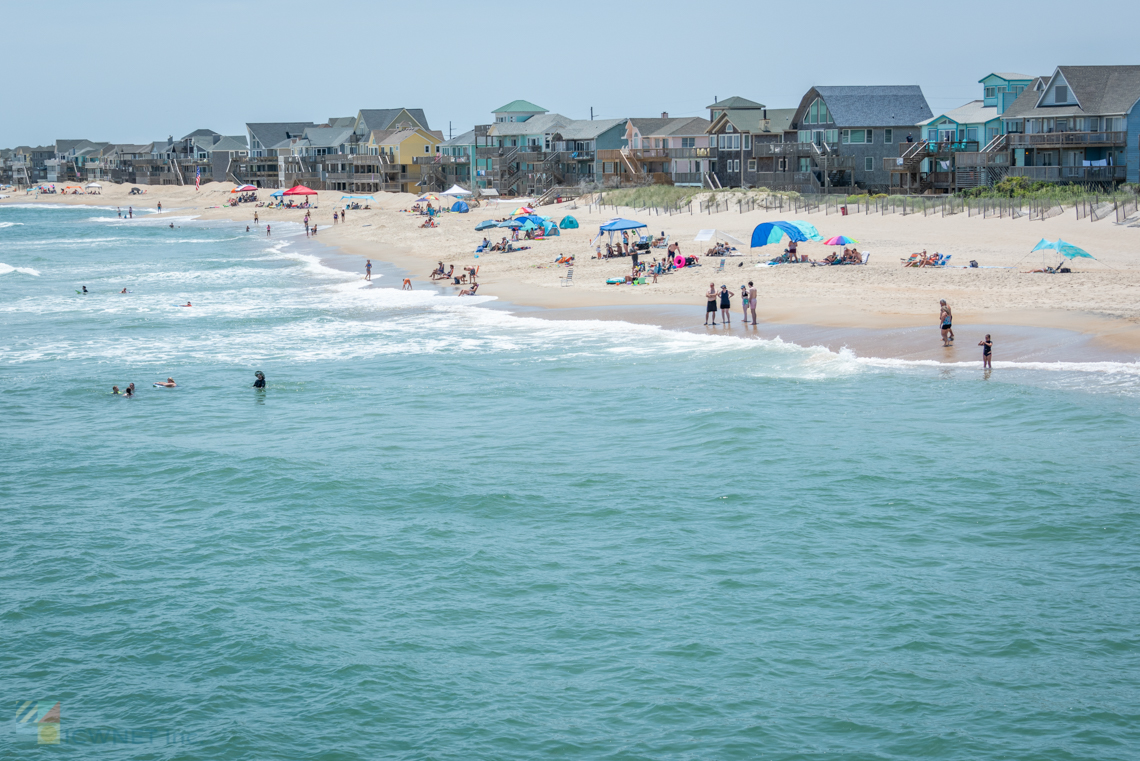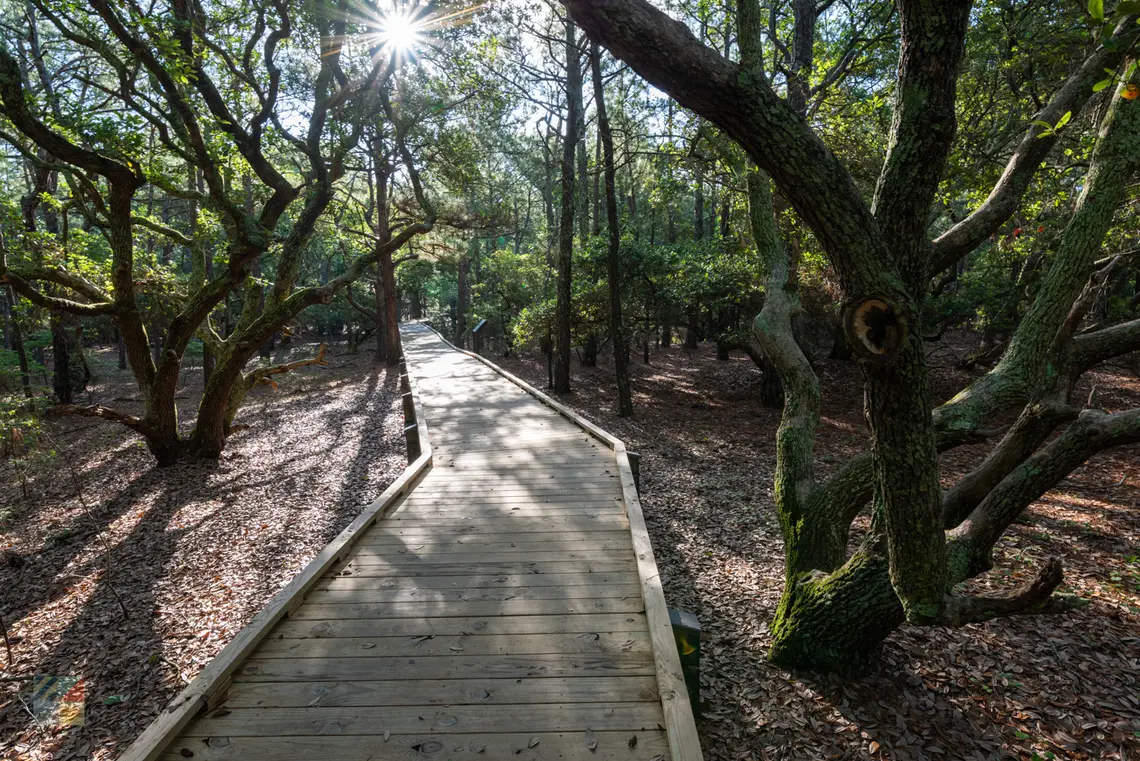We'd like to thank Captain Johnny's Dolphin Tours for supporting our ghost crabbing article. Visitors of all ages enjoy this two hour cruise in the protected waters of the Roanoke Sound. Learn about bottlenose dolphins, then see them in person with a 98% success rate. Several tour times are available Monday thru Friday, May to October. Morning tours, sunset cruises and private tours are available. Visit their site here or call 252-473-1475 for more information.
When it comes to surf fishing, it’s hard to beat the coastline of North Carolina. Well known for hundreds of miles of beaches where record-breaking catches are landed on a regular basis, the North Carolina shoreline is arguably one of the top destinations for surf fishermen in the U.S.
So if you are new to the N.C. coastline, or just want to brush up on your surf fishing insight, take a closer look at everything you need to know about casting from the coast, and get ready for plenty of opportunities to reel in the catch of a lifetime.
Permits
https://www.ncwildlife.org/
Every state has specific rules and regulations in place to help manage natural resources, and North Carolina is no different. One of the ways these conservation efforts are funded is through saltwater fishing licenses, which help to support fisheries management programs, like hatcheries, habitat research, and fish stocking.
As such, all anglers who fish along the North Carolina beaches, sounds, and any body of saltwater on the coast or barely inland will need to have a Coastal Recreational Fishing License, (also known as a saltwater fishing license.)
Here’s what you need to know about obtaining a saltwater fishing license in North Carolina:
- Licenses are sold via the North Carolina Wildlife Resources Commission, and can be purchased online at https://www.ncwildlife.org/.
- In addition, licenses can be purchased at the majority of local bait and tackle stores throughout the N.C. coastline, as well as at major sporting goods stores.
- A license is required for all anglers over the age of 16.
- A license is generally NOT required for fishing off a public fishing pier
- The coastal recreational fishing license allows anglers to fish in all coastal waters, but not in inland, fresh waters. A separate license – the Unified Fishing License – will allow anglers to fish in all waters across the state.
- A fishing license is not required for clamming or harvesting oysters, as the license is only required for finfish species.
- There are multiple types of coastal recreational fishing licenses available, which vary in price by timeframe, as well as the license holder’s state of origin. (I.e., North Carolina residents pay less for a saltwater fishing license.)
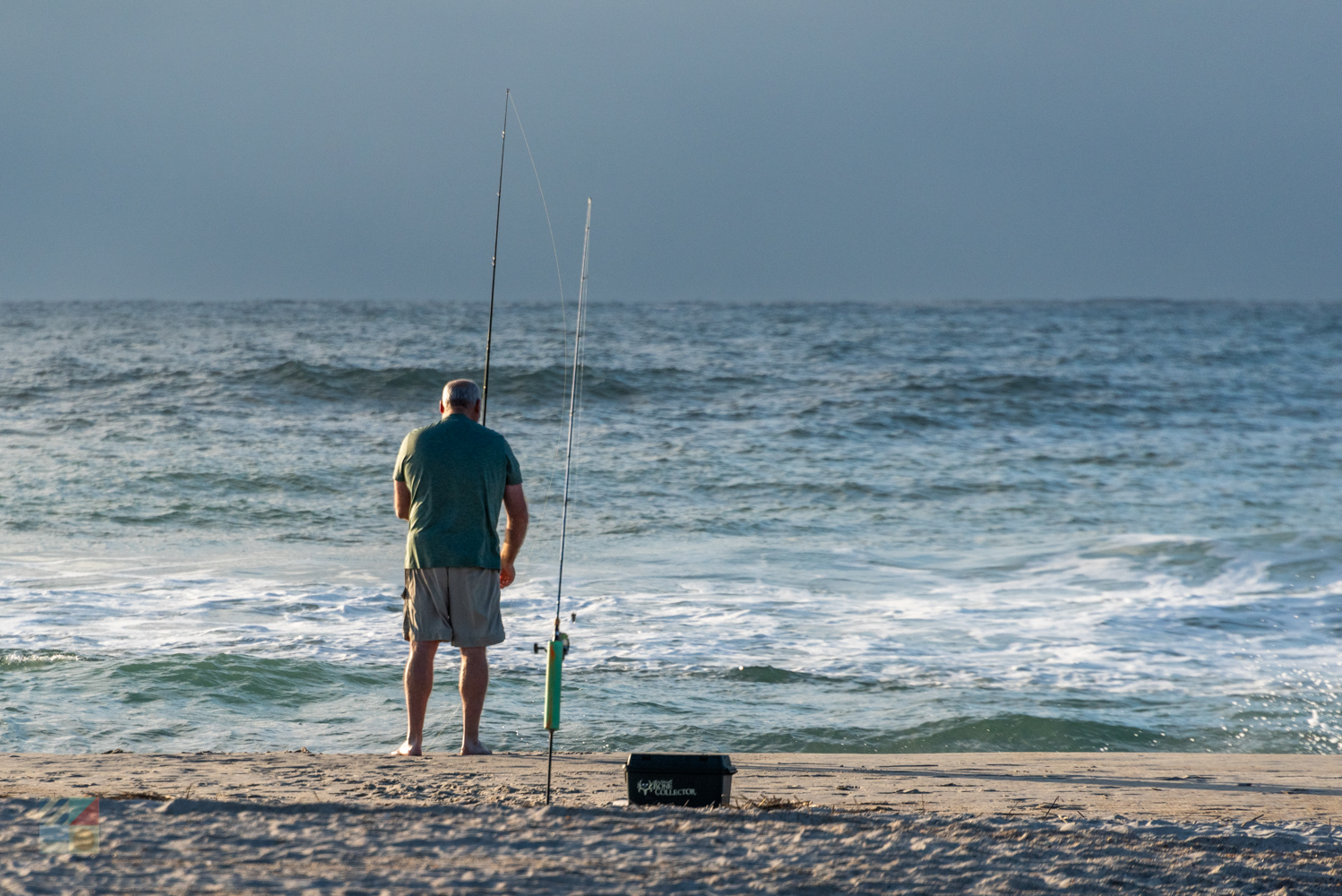
Surf Fishing Gear
Once you have your coastal recreational fishing license in hand, it’s time to start thinking about gear. Anglers will find tons of options when it comes to equipment for casting into the surf, from custom designed rods and reels at local tackle shops, to name brand varieties that are designed for multiple areas along the coastline.
We were not provided with free or discounted products to review. These recommendations were not influenced by manufacturers. We did, however, heavily consider customer reviews at retail websites when deciding which products to feature. We like these products, but we took care to make sure other customers agree. Some of the product links include affiliate codes. If a purchase is made, OuterBanks.com is paid a commission for the referral.
See our full surf fishing gear guide including rods, reels, line, rigs, carts, waders and more.
Surf Fishing Rod and Reel Combos
Rods can be purchased separately, or as a rod and reel combo. Though the length can vary by beach and surf conditions, local anglers traditionally recommend using an 8′ to 16′ light to medium surf type rod, which can adapt to most conditions and most species. Keep in mind that the rod you choose has a lot to do with your physical size – some rods are heavy, and can tire out an angler quickly after multiple casts.
PENN Squadron III 8’ Surf Spinning Fishing Rod; 2-Piece, 12-20lb Line Rating, Medium Rod Power...
PENN SQUADRON II 8’ SPINNING ROD: Built for versatility and dependability. Surf spinning rod with premium hardware and two-piece graphite construction. * 12-20LB LINE RATING, MEDIUM POWER: Moderate...
PENN 10’ Pursuit IV 2-Piece Fishing Rod and Reel (Size 4000) Surf Spinning Combos, 10’, 2...
PENN PURSUIT IV 10’ FISHING ROD AND REEL SPINNING COMBO: A battle-tested and durable fish-taming kit for saltwater anglers. * LIGHTWEIGHT AND DEPENDABLE: 2-piece, Graphite Composite rod blank with...
PENN Battle Spinning Reel and Fishing Rod Combo Kit with Spare Spool and Reel Cover, Black, 6000 ...
Kit includes spare anodized aluminum spool and a durable neoprene reel cover. The perfect pairing to go along with this high-performing Penn Battle spinning combo * 5+1 stainless steel bearing...
Surf Fishing Line
Your line will literally make or break your ability to reel in a catch. Look for 20-25 test line for the best results in all conditions, and go for Nylon Monofilament, Fluorocarbon, or Braided Line varieties in terms of materials. Monofilament nylon is a great choice for new anglers, as it is fairly cheap, knots well, and has an inherent stretch, which is a great attribute for surf fishermen who are developing their skills.
Hi-Seas Quattro Monofilament Line, 30 lb / 11.3 kg Test, .022 in / 0.55 mm Dia, 4-Color Camo, 400...
USE: Monofilament fishing line to catch stripers, bluefish,marlin, grouper, or any other tough fish that requires a strong main line in saltwater. * QUALITY: Quattro monfilament fishing line is...
Berkley Trilene® Big Game™, Clear, 20lb | 9kg, 650yd | 594m Monofilament Fishing Line, Suitable...
BERKLEY TRILENE BIG GAME: Don't let fish off the hook. This heavy duty fishing line was designed to deliver incredible durability, reliability, and value. * EXTREME FIGHTING POWER: This mono fishing...
Rigs for Surf Fishing
Like all gear designed for surf fishing, when it comes to rigs and rig set-ups, there are a lot of options, which generally depend on the fish you are targeting, the season, and other conditions and factors that change depending on where along the North Carolina coastline you land. In fact, there is likely a unique and distinct type of rig available for every species of fish, and every type of body of saltwater.
YOTO Fishing Leaders,Saltwater Tackle Rig with Swivels Snap, High-Strength Fishing Wire Gear...
2 arm 12pcs white nylon monofilament leaders,main leader test 90lb, arm leader test 55lb, keep hooks free of leader. * When it's time to protect or strengthen your main line, using a steel fishing...
SURF FISHING TACKLE: Includes 12pcs fishing leaders, 4pcs pyramid sinker weight, 1pc bass casting sinker * HIGH QUALITY: All of the surf fishing tackle kit are made with the high quality material...
Rod holders
Sand spike and other varieties of rod holders will hold your rod in place when you need a break, or just want to enjoy a little downtime relaxing on the beach. This piece of equipment comes in a variety of different materials – such as PVC or aluminum – as well as different lengths, and different price ranges. Rod holders that are made of PVC or ABS plastic are traditionally the least expensive, but if you’re in rough ocean conditions and do a lot of surf fishing, upgrading to a more durable metal rod holder may be your best rouet.
Berkley Spiral Rod Holder , Red
BERKLEY SPIRAL ROD HOLDER: A simple and effective way to free your hands and secure your rods while fishing on the bank. Holds most rods. * DEPENDABLE & DURABLE: Made of high-quality powder-coated...
The Beast Sand Spike Rod Holder / 57 inches/Aluminum/Stainless Steel Hardware
Inside diameter 1.65”, 2” angle, 1/8” thick, 57”, plastic reel protector. * 100% Aluminum with stainless steel hardware. * Knee plate is great for pushing the Beast deep into beach sand.
Pyramid weights
A pyramid weight is often the preferred weight for surf fishermen, as it can stand up to currents and hold at the bottom. A roughly 2 oz. to 4 oz. pyramid weight should hold strong in most ocean conditions, when used in conjunction with a surf rod. If it’s a rough day, or you are fishing on a beach with large breakers close to the shore, up the weight a bit to hold strong in the surf.
Pyramid Sinkers are triangular in shape and are excellent for surf fishing and pier fishing. They hold well in sandy bottoms, and also hold well in rough currents like the surf. Great for saltwater...
Cart
A cart will make a surf fisherman’s life infinitely easier when heading to and from the beach. Built to be pulled across the sand with ease, and large enough to hold all the essential equipment and then some, a beach cart is a great way to pack and tote along all the equipment you’ll need for a full day on the sand.
Look for carts that can hold a lot of weight – you may be bringing back plenty of big catches, after all – as well as carts that have larger than normal, sturdy wheels. Larger wheels will essentially transform a standard cart into a 4WD mode of transportation that can easily haul your supplies across soft sand.
Fish N Mate Angler's 303 Jr Fishing Cart with Poly Wheels
Inflatable Poly Wheel Tires Designed to Work on Soft Sand * Stabilizer Legs * Food grade Cutting Board with Removable Bait Bucket * Inside Frame: 9"X14.5"X34" * Outside Frame: 14"X28"X39" (with...
Sea Striker Balloon Tire Surf and Beach Cart - Outdoor Fishing Rolling Wheel Wagon
Surf Cart: This all-around, versatile cart has a heavy-duty frame and comes with the capability to hold up to MOST 55-quart coolers. Carry up to 125 lbs. of beach items and surf fishing equipment to...
Waders
If you want a longer cast, and you prefer to fish in colder or cooler weather, waders will be your best friend. Waders are effectively worn like overalls, protecting the lower 3/4th of your body from water inundation when you wade out to the surf to cast.
Don’t skimp on quality when it comes to waders! Inexpensive varieties can leak, which can turn a great fishing day into a bad one fairly quickly.
FROGG TOGGS Men's Amphib Bootfoot Neoprene Cleated Chest Wader, Cleated , 12
WATERPROOF – 3.5mm premium neoprene construction is triple stitched seams and glued and taped for dependable protection * BOOTS – 200-gram Thinsulate boots available in cleated or felt outsole ...
FROGG TOGGS Hellbender Breathable Waterproof Stockingfoot Fishing Chest Wader for Fishing...
WATERPROOF and BREATHABLE – 4-ply Nylon Upper constructed with DRIPORE Gen 2 material. Breathable, lightweight, abrasion-resistant, 100% waterproof * NEOPRENE BOOTIES – 4mm Waterproof, double...
Bait and Lures
One of the hardest decisions for surf fishermen is what type of bait, or artificial lure, to use for the best results. Many local tackle shops can direct new anglers in the right direction when it comes to what’s biting, and what bait or lures to use, but here’s a closer look at some of the most popular varieties for fishing along coastal North Carolina.
Bait
- Shrimp – Virtually all saltwater species are attracted to shrimp, which is why it’s found in just about every bait and tackle store up and down the North Carolina coastline. Fresh shrimp is generally preferred over frozen if you can find it, and it’s recommended that you remove the head, cut the shrimp into 3-4 bite-sized pieces if desired, and hook the shrimp through the dorsal back so that it stays securely on the hook.
- Sand Fleas – Sand fleas are a great (and effective) on-the-spot option when surf fishermen are out of bait, or out of money. In the summer months, sand fleas can often be obtained by digging through the sand close to the ocean wash. Able to attract a wide array of species, sand fleas can also be purchased at bait and tackle stores when they aren’t plentiful along the shoreline.
- Mullet – Cut mullet is another catch-all bait that can attract a wide array of species. Discard the tail, and cut into small chunks for the best results. Small bait mullet can also be caught for free in area sounds, saltwater canals, marshes, and other calm salty waters with a bucket or a cast net.
- Menhaden – Menhaden is a cut-bait fish that is popular with bluefish, sea trout, and striped bass – some of the most prevalent species along the North Carolina coastline. Most bait shops will have menhaden available, which can be easily cut and hooked.
- Squid – Squid is a frequent option at North Carolina bait shops, as it works well with saltwater species of all varieties, and of all sizes. Use whole smaller squids for targeting the big fish, or cut up squid into smaller piece.
- Clams and Oysters – Though tricky to hook, clams and oysters can attract a wide array of species. Just be sure and stock up – it’s easy for this bait to slide off a hook in rougher ocean conditions.
- Bloodworms or ragworms – Bloodworms are also available in most all North Carolina bait and tackle stores, as they work well in all conditions, for all types of fish. (They’re also nicely inexpensive!) Best of all, bloodworms can be used for surf fishing, as well as targeting inland streams, canals, and sound waters throughout the coastline.
Lures
When it comes to lures, there are plenty of options, and what an angler uses is all dependent on where they are headed, and what they are targeting. Bait and tackle store will provide the best recommendations for lures to use for specific species, weather conditions, and seasons, but there are a few popular varieties to try that can work in most any coastal fishing environment.
Here are some of the most popular types of lures for saltwater fishing.
Berkley Johnson Sprite Fishing Hard Bait, Gold - Redfish Kit, 2 1/2in - 3/4 oz
Sprite redfish lure spoon effective on all predatory fish species * Comes with unique zig zag wobble and red teaser tab adding attraction for predatory fish as is oscillates back and forth ...
Goture Soft Lures Shrimp Bait Set, Freshwater/Saltwater, Trout Bass Salmon, 12 Piece
Premium quality: Soft lures shrimp bait set made with premium high quality plastic soft, flexible * Life like: Soft lures shrimp bait with a realistic design and makes it hard to resist for fish ...
Yo-Zuri 3D Inshore Twitchbait Slow Sinking Lure, Mullet, 90mm/3-1/2
All new flat sided lipless twitch bait with internal 3D prism finish * Perfectly balanced for quick starting action * Saltwater grade hooks and split rings * Inner hologram Sheet * Quick response by...
Other Gear You’ll Need for Surf Fishing
In addition to all of the above essentials, there are some other tools you’ll need to bring along to ensure you have everything you need for a full day (or night) of surf fishing along the North Carolina coastline. Available at bait and tackle stores, sporting goods stores, and even traditional beach shops or grocery stores, look for these items that will make it easier to spend long hours on the beach.
Flying Fisherman Buchanan Sunglasses for Men, Women, Fishing, Boating, Outdoor Sports, 100% UV...
BUCHANAN STYLE - FRAMES: Polycarbonate Matte Crystal Gunmetal | LENSES: Polarized Triacetate with AcuTint | COPPER TINT: A copper/rose lens tint favored for sight fishing, muddy water and very low...
★ Plating Titanium Process makes this fishing gear antioxidant, corrosion-proof, colorfast, UV resistant, high hardness in saltwater and other damp and harsh environment. * ★ Small Jaws of...
Piscifun Fishing Pliers, Saltwater Fishing Pliers with Split Ring, Fish Hook Remover, Corrosion...
Gifts for Fisherman:Add ultralight Piscifun Saltwater Aluminum Fishing Pliers Gear to your fishing box. Make your hook removal much easier. Fish on! * Anti-Corrosion Materia:The aircraft-grade...
KastKing Speed Demon Pro Fillet Knife - Razor Sharp G4116 German Stainless-Steel Blade...
G4116 German Stainless Blades – The razor sharp G4116 German Stainless-Steel blade has a beautiful black finish and will maintain its edge longer to make the job of cutting bait easier. * Serrated...
PLANO Z SERIES 3700 TACKLE BAG: The Z-Series Tackle Bag is durably designed with a waterproof base, PVC fabric, and easy-access attachment points. Dimensions: 10”L x 18.8”W x 10.2”H. * THE...
Natural Conditions
Surf fishing in North Carolina is naturally affected by the weather. Different species can be abundant or non-existent depending on so many natural factors, such as the season, the weather, the tides, and the inherent shape of the shoreline itself.
If you want to know what to target, and how successful you’ll be when you start casting, then you need to know the fundamentals of a North Carolina beach when it comes to surf fishing. Here’s a little insight on the basic elements that impact surf fishing from Duck to Oak Island and Holden Beach, and how you can use these varying factors to your best advantage.
Seasons
A number of saltwater species that frequent the North Carolina coastline are seasonal, which means that they are always on the move as they migrate up and down the coastline. The always popular red and black drum are notorious for this movement and seasonal appearances, as they can be found in droves when the conditions are just right, and they en route along the East Coast.
A good rule of thumb when it comes to seasonal and migrating species is that they tend to head north for the summer, and tend to head south for the winter. This is why the late spring, early summer, and fall are arguably the best times for surf fishing in North Carolina. During these times of year, anglers have the best chances of reeling in migratory catches, as well as local species that are at their most abundant close to shore when the water temperatures are warm.
Weather
Ideal weather conditions for surf fishing can be tricky to pinpoint because there are all sorts of different factors to consider. An onshore breeze can provide an increase in larger fish swimming closer to shore, but conditions that are too windy can affect the clarity of the water, and can make surf fishing difficult. Needless to say, rain can also hinder the water quality, and can make a day of surf fishing a soggy experience.
On the whole, aim for sunny days with a light onshore breeze. A low pressure is considered preferable to a high pressure during a spring tide, and if the weather conditions aren’t conducive for fishing, (like extremely windy days, or where there’s an offshore hurricane in the area), and the conditions have been poor for more than a day, it’s best to wait a day or two before heading out to the beach again. It typically takes at least a day for fish to acclimate after a bout of severe weather, and to return to the waters close to shore after the bad weather has subsided.
Tides and Time of Day
Tides have a major influence on surf fishing all along the North Carolina coastline, and a general rule of thumb is that high tide is better than low tide, simply because it’s easier to reach deeper waters with every cast. Try to aim for high tide, or up to two hours before or after a high tide. Slack tide – or the time period right in between low and high tide – is generally not as productive for surf fishing.
As for time of day, early morning and dusk are typically when a number of varying species feed. So head out to the beach before 9 a.m. or about an hour or so before sunset. Not only will you miss the sunbathers and other beach crowds, but you’ll also have the best chance of taking advantage of the nocturnal feeding habits of a wide array of saltwater fish.
Reading the ocean waters
Experienced surf fishermen can generally tell if a beach is good for fishing with just a few casts, or even a quick look. Considering that the North Carolina shoreline varies greatly with every mile, there are a few things to look for when it comes to determining if your stretch of sand will be a solid fishing spot.
- Sloughs – A slough is a deep trough of ocean water that is located close to shore and which runs parallel to the beach. A slough can be a haven for all varieties of saltwater fish, so casting into this trough can yield great results. Look for waves that are breaking offshore, and then dissipating before they get closer to the beach. (i.e., an outlying sandbar that grows deeper close to the shoreline.) This will be a sign that there’s a slough present, and it’s a good beach for fishing.
- Sand and depths – As a rule of thumb, the deeper the water is close to shore, the better your luck will be at surf fishing. Look for beaches with steep slopes and soft, course sand, which indicate that the adjacent ocean shoreline has a steep and deep slope as well. Also, look for waves that are breaking close to shore – or hardly any waves at all – to determine if the ocean waters are nice and deep next to the shoreline.
- Wild waters – If you spot a collection of birds or other wildlife congregating in one location on the open waters, chances are that they’re feeding on a passing school of fish. As such, this is always a good indicator that the fishing conditions are currently exceptional.
- Jetties, piers, and bridges – At multiple points along the coastline, jetties, bridges and piers can be popular fishing spots, simply because the presence of underwater structures attract so many different varieties of fish. In addition, a bridge - (like the Little Bridge in Manteo or the Bonner Bridge just south or Oregon Inlet) - can allow anglers to cast into deeper waters, well away from the shoreline.
- Inlets – Inlets are notoriously productive fishing grounds as the deep and steady currents allow multiple species of fish ample opportunities to access varying fishing grounds in the ocean or sound. Head to the edge of a sound or oceanfront beach on the edge of an inlet for surf fishing at its arguable best.
Avoiding dangers
When the weather conditions aren’t right, surf fishing can actually be a potentially dangerous sport. To mitigate the odds of injury, stick to the following tips that will ensure you remain safe on every trip to a North Carolina beach.
- Never fish alone, and if that’s not possible, always let someone know where you’re going. Use mile markers and landmarks to indicate where you’ll land along the beach, and keep this information handy in case an emergency occurs, and you need to call for help.
- If you’re taking a 4WD vehicle to go surf fishing, be sure and air down your tires to 20 psi at most, and never park below the high tide line. If you get stuck, and you’re below the tide line, you may damage or even lose your vehicle to approaching ocean waves and saltwater.
- Watch out for swimmers, surfers, and other beach-goers who may be sharing the shoreline.
- Use caution in inlets, and at beaches known for their currents and constantly changing conditions, like the famous Cape Point on Hatteras Island. Never wade too far out into an inlet, and avoid walking on inlet sandbars when there is an incoming tide, as they tend to disappear quickly as the waters rise.
- Bring sunscreen! The intensity of the sun increases along the beach, as the sun is reflected off the ocean waters. As a result, sunscreen is a must all year long, despite the outdoor temperatures.
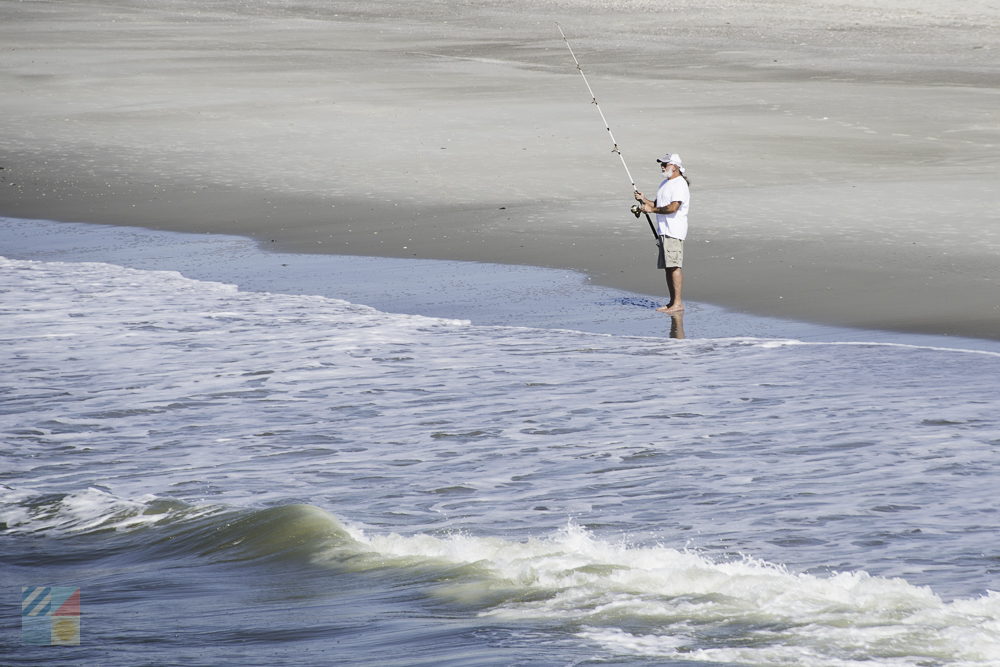
Casting, Hooking and Reeling
There are several techniques when it comes to casting, hooking, and reeling in fish, which depend on where you land along the North Carolina coastline. How you fish from a pier will likely be different from how you fish from along the shore, and there are a myriad of considerations to keep in mind for both types of saltwater fishing.
Pier fishing
Pier fishing is popular in coastal North Carolina simply because it is so plentiful, and can have so many big rewards. There are multiple fishing piers located in every developed corner of the North Carolina coastline, which includes the Outer Banks, Hatteras Island, the Crystal Coast, the Cape Fear area, and the Brunswick Islands, so no matter where you land, (with the exception of isolated barrier islands like the Cape Lookout National Seashore), chances are that you’ll be close to a local fishing pier.
A saltwater fishing license is also not required to fish from a North Carolina pier, and many piers offer on-site bait and tackle stores, convenience stores, or even full-service restaurants and bars. But the primary benefit to fishing off an oceanfront pier as opposed to a local beach is all about the location. The fishing piers on the North Carolina coastline can extend anywhere from 600’ feet to 1000’ feet or more into the Atlantic Ocean, which means that you’re that much close to the big catches that are found slightly offshore. In fact, in the summer months, it’s not that uncommon to hear reports of dolphin or even wahoo catches, which are offshore species that tend to trickle in closer to the beach when water temperatures are high enough.
Techniques, tips and tricks for pier fishing
Keep the following in mind on your next pier fishing trip to maximize your chances of reeling in plenty of catches.
- Don’t cast too far – One of the best things about pier fishing is that it doesn’t require much effort when it comes to casting, as fish are naturally attracted to the underwater pilings and structures that are directly under the pier.
- Watch the birds – Birds hang around oceanfront piers for good reason -they’re looking for fish, just like you. Watch the birds and see what areas of the surrounding waters they tend to target for the best chance of finding fish in the immediate area.
- Look for changes in the water – Fish are naturally attracted to changes in the water, so look for areas where the water goes from cloudy to clear, or from dark to light.
- Bring polarized sunglasses – Not only will they protect your eyes from the hot sun that reflects off the surrounding waters, but they’ll help you spot fish that are well beneath the surface in deeper waters off the pier.
- Look into pass options – It costs money to go pier fishing, but if you regularly fish from your local fishing pier, it may be worth it to look into seasonal or annual passes. Long-term passes for a week, month, or even a year can save you big in the long run.
- If you don’t know what’s biting, ask! The folks who man the North Carolina fishing piers know their stuff. Ask for recommendations on bait, rigs, and what’s biting and when, to boost your chances of success.
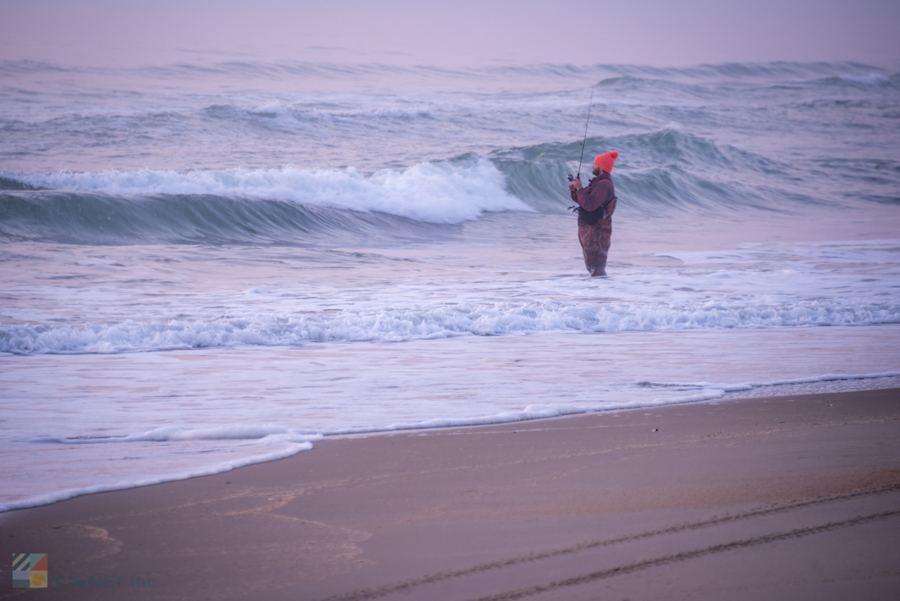
Surfcasting
Surfcasting, or beachcasting, is easily the most popular form of fishing along the North Carolina coastline, simply because it can be done on any stretch of shoreline, and in any weather. With the exception of seasonal closures for endangered bird or sea turtle nesting, all stretches of the North Carolina shoreline are open to anglers, which literally gives fishermen hundreds of miles of options when it comes to finding a spot to fish.
Surfcasting involves wading out into the ocean waters or standing on the edge of the beach and casting a line as far as it can go. The casting rods used in surf fishing are generally long and can range anywhere from 10 to 16’ feet, and while casting, anglers will use both their hands and their entire bodies to propel the rig as far as it can go. It’s a challenging skill to master for newcomers, and there are even surfcasting competitions around North Carolina, and around the world, for casting a line the farthest distance. (Currently, the world record for casting is at 313 yards.)
The benefits of surfcasting are endless. It’s easy, convenient, and can be done anywhere, and as far as fishing goes, it’s the least expensive type of fishing you’ll find along the oceanfront shoreline. Perhaps best of all, it’s a sport that can be enjoyed by anyone – regardless of age, skill, or familiarity with the beaches of North Carolina.
With that being said, there are a few tips, tricks and techniques that anglers can keep in mind to make their surfcasting as fruitful as possible.
Techniques, tips and tricks for surfcasting
- Find a solid rig – Many experts attest that the best surf fishing rig set-up is the Fish Finder Rig, which is easily one of the most popular rigs for surf fishing along the North Carolina coast.
- Do some recon first – Head to your local beaches around low tide and look for sloughs, deep waters, dips, sandbars, and structures, which will all indicate great fishing grounds when high tide rolls around in few hours.
- Go with live bait – Though artificial bait can certainly be used for surfcasting, (and can be very successful), live bait is generally preferred for fishing from the beach into the open waters
- Take the truck – Anglers can cover more ground, (especially during initial recon missions), if they utilize a 4WD vehicle to explore the area beaches. This is especially true for hard-to-reach but popular surf fishing beaches like Cape Point on Hatteras Island or Ocracoke Island and Cape Lookout National Seashore. Best of all, it’s easier to haul all your gear to the shoreline.
- Buy a rod holder – Makeshift rod holders that are made out of buckets, coolers, or holes dug in the sand itself may be cost effective, but they won’t hold your rod very well if you get a big bite. Invest in rod holders, or at the very least, get some cut PVC pipe if you want a do-it-yourself variety.
- Don’t overdo the cast – The fish may be closer than you think, and this is especially true in areas that have sloughs close to shore. Aim for deep waters, and not just waters that are far away from the shoreline, for the best results.
- Be an early bird or a night owl – By arriving to the beach early or late, you’ll have the best chance of catching fish that feed during these times of day, while avoiding swimmers, surfers, and other folks enjoying the shoreline.
- Look for fishing crowds – The locals know where to go, so if you see a dozen of more fishermen congregated in one spot, then chances are you’ve stumbled upon a good fishing hole. Just don’t set up too close to people who are already fishing – nothing ruffles a local fisherman’s feathers more than getting their lines twisted with a new arrival.
- Practice close to inlets – The good thing about fishing near an inlet is that you don’t have to cast very far to reach potentially deep and fruitful waters. So if you’re new to surf fishing and haven’t perfected your cast just yet, try heading to the beach close to a local North Carolina inlet for the best results. Just don’t wade out very far, if at all – inlet waters can be deceptively swift and are ever-changing.
What you’ll catch when on the beaches of North Carolina
One of the best things about surf fishing in North Carolina is that every season and stretch of shoreline changes. What you’ll catch in the winter months is often distinctively different than what you’ll land in the summertime, and what you might catch in a warmer region like Oak Island could be different than what you’d catch along the Currituck County beaches during identical times of year.
With that being said, there are a variety of popular saltwater species that can veritably pop up anywhere along the coastline, from the northern Virginia border, to the southern South Carolina state line. So when you go surf fishing, be on the lookout for these types of fish that frequent the ocean waters off the North Carolina coast, and which are popular and sometimes coveted catches for local and visiting fishermen alike.
Types of fish and seasons
-
Croaker
- Known Aliases: Hardhead fish, pinfish, kingfish
- Season: Generally spring through fall, but can linger into the winter and summer months
- Catch Limits: None
- Where you’ll find them: These bottom feeders are typically found in sloughs or deep holes along the beach, especially around high tide
- How you’ll catch them: Light tackle works well, especially with live bait such as worms, shrimp, or squid.
-
Black Drum
- Known Aliases: Drum
- Season: March through May, and September through December
- Catch Limits: Length of 14”-25”, and a bag limit of 10 per day
- Where you’ll find them: All along the beaches when the drum run is on.
- How you’ll catch them: A bottom rig with a sinker, and plenty of live bait – no artificial lures for this species.
-
Red Drum
- Known Aliases: Channel Bass, Redfish, Puppy Drum
- Season: Spring months of March through June, fall months of September through December
- Catch Limits: 18”-27” long, and a bag limit of 1 per day
- Where you’ll find them: By surf fishing anywhere along the coastline. Spot fishing works too when the drum arrive in droves.
- How you’ll catch them: Cut bait or live bait seems to work best.
-
Bluefish
- Known Aliases: Blues, Snappers, Choppers, Taylor Blues
- Season: Generally March through November, but can also be caught in the winter months on occasion
- Catch Limits: bag limit of 15 per day, and only 5 per day for bluefish that are greater than 24” long
- Where you’ll find them: Off the pier and along the beach, and all along the North Carolina coast
- How you’ll catch them: Bottom fishing on cut bait or artificial lures. Watch out for their teeth, which are razor sharp.
-
Cobia
- Known Aliases: Lemonfish
- Season: April through August when the waters are warm
- Catch Limits: Regulations change based on season and number of fish caught. See http://www.ncmarinefisheries.net/web/mf for more information.
- Where you’ll find them: Off the local piers and near the inlets
- How you’ll catch them: Live bait – especially mullet – works well. Chumming is a good option too.
-
Pompano
- Known Aliases: Florida Pompano
- Season: Late summer when water temps are at their highest
- Catch Limits: None
- Where you’ll find them: Pompano frequent the beach close to shore, just past the breaking waves. Especially common in clear and warm ocean waters.
- How you’ll catch them: Bottom rigs with natural bait, like sand fleas, cut mullet, or shrimp.
-
Gulf Flounder
- Known Aliases: Flounder
- Season: Late May or early June until December
- Limits: 15” long minimum, bag limit of 4 per day
- Where you’ll find them: On the bottom of the ocean floor. Use a bottom rig, or try flounder gigging.
- How you’ll catch them: Both live and artificial finger mullets work well.
-
Summer Flounder
- Known Aliases: Flounder
- Season: Late May or early June until December
- Catch Limits: 15” long minimum, and a bag limit of 6 per day
- Where you’ll find them: On the bottom of the ocean floor. Use a bottom rig, or try flounder gigging.
- How you’ll catch them: Cut bait, minnows, Bucktail lures, and jigs
-
King Mackerel
- Known Aliases: King, Kingfish, Snakes, Smokers
- Season: April through June, and September through December
- Catch Limits: 24” long minimum, and a bag limit of 3 per day
- Where you’ll find them: Head to the end of the pier!
- How you’ll catch them: Use a slow reeling technique with live minnows, menhaden, or even mullet, or try spoons and jigs as artificial lures
-
Sea Mullet
- Known Aliases: Whiting, Virginia Mullet, Roundhead
- Season: April through November
- Catch Limits: Bag limit of 200 per day
- Where you’ll find them: Piers are great for sea mullet, but you can also find them all along the beach.
- How you’ll catch them: Use a bottom rig with two hooks and live bait, such as shrimp, sand fleas, squid, or blood worms.
-
Sheepshead
- Known Aliases: None
- Season: Can potentially be found year-round
- Catch Limits: 10” long minimum, and a bag limit of 10 per day
- Where you’ll find them: Near submerged structures, such as bridge pilings or duck blind pilings in the sound
- How you’ll catch them: All kinds of live bait works, including crabs, sand fleas, clams, and shrimp
-
Spot
- Known Aliases: Yellow Belly
- Season: Can potentially be found year-round
- Catch Limits: None
- Where you’ll find them: Everywhere along the beach, and also off the piers
- How you’ll catch them: A two-hook bottom rig with bloodworms, shrimp, or squid works well
-
Striped Bass
- Known Aliases: Rockfish
- Season: October through April
- Catch Limits: Varies – visit this site for more info
- Where you’ll find them: Along the beach and area piers
- How you’ll catch them: Just about any kind of rig will work, but try casting or jigging with artificial lures such as spoons.
-
Gray Trout
- Known Aliases: Weakfish, Trout
- Season: Late April or May through December
- Catch Limits: 12” long minimum, and a bag limit of 1 per day
- Where you’ll find them: Along the beach and piers
- How you’ll catch them: All rigs work well, but be careful reeling them in, as the aptly named “weakfish” has a weak mouth that can tear the hook through the lip.
Surf fishing in North Carolina is arguably one of the best and most popular activities on the beach. Enjoyed anywhere, and at any time of year, surf fishing can be a great way to spend lingering days along North Carolina’s hundreds of miles of stunning shorelines.
From the isolated barrier islands of Hatteras Island and the Cape Lookout National Seashore, to the bustling beach towns of Carolina Beach, Oak Island, and Nags Head, any stretch of sand can yield some spectacular results. So be sure and bring along your gear, your fishing license, and your luck – you never know what you’ll land when you try surf fishing in North Carolina.
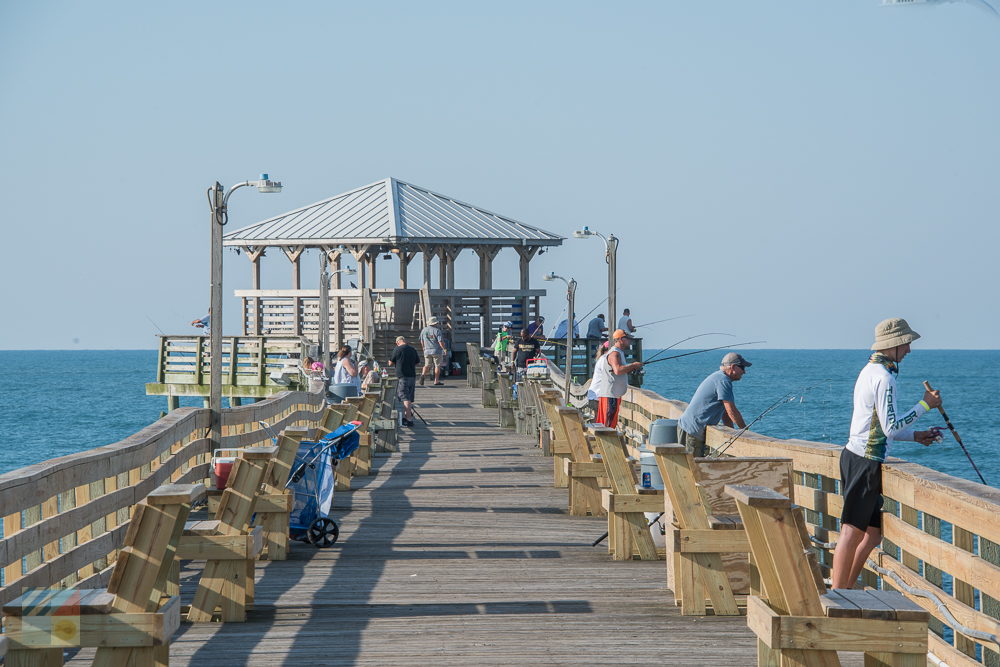
We'd like to thank Captain Johnny's Dolphin Tours for supporting our ghost crabbing article. Visitors of all ages enjoy this two hour cruise in the protected waters of the Roanoke Sound. Learn about bottlenose dolphins, then see them in person with a 98% success rate. Several tour times are available Monday thru Friday, May to October. Morning tours, sunset cruises and private tours are available. Visit their site here or call 252-473-1475 for more information.
Best Pizza in in Corolla since 1995! Cosmo’s Pizzeria has continued to be a family favorite on the northern Outer Banks for over 15 years. Outdoor dining, full bar, and specialty menu (including gluten-free pizza) are a few of our many...
Corolla, North Carolina is a must see nautical village scented with the spray of the salty sea. It's located on NC Highway 12 along a thin strip of land bordered on the east by the tempestuous Atlantic Ocean, and on the west by the inland waterway...
ZoomAround Street Legal Golf Cart Rentals provides our communities and our visitors with fun, safe and convenient access to innovative transportation while providing an unparalleled customer experience. Don’t carry all of your beach gear...
Head south over the Marc Basnight bridge, or take the Hatteras / Ocracoke ferry from Ocracoke Island, and you'll land on the shores of Hatteras Island.
Join Captain Stuart Wescott aboard The Captain Johnny boat for a Guaranteed Dolphin Watch cruise in protected waters off the Outer Banks, NC. This two hour cruise is ideal for all ages. Enjoy breathtaking views as you listen to a...
It's easy to see why vacationers fall in love with Carova. Located almost literally off the Outer Banks map, while other towns along the barrier islands of North Carolina grew and developed over the decades and became popular East Coast tourism...
With the best views around and the quickest access to dolphins, Paradise Dolphin Cruises is committed to offering you one of the most amazing experiences of your life! Climb aboard the Kokomo, our 40-passenger catarmaran and the area’s newest...
The Ocracoke Island Lighthouse may not be the most imposing of the Outer Banks lighthouses, but as North Carolina's oldest lighthouse in operation, (and the second oldest in the United States), it is certainly one of the most beloved. At just 65...
Welcome to the home of the happy oyster where for over 40 years the oyster has been our world. The Outer Banks only authentic oyster bar is the place to enjoy sensational fare from the sea washed down with your favorite brew or cocktail. We serve by...

